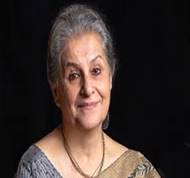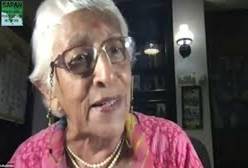Trees at Gah and Manmohan Singh. Collage by Pragyan Srivastava. Dr Manmohan Singh, Prime Minister of India 2004-2014, passed away on Thursday in New Delhi at the age of 92. Under his leadership, India, the largest democracy in the world, experienced an economic boom. But he never forgot his roots in the village of Gah, Punjab, where he was born in 1932, an area allocated to Pakistan after the Partition of 1947
South Asia Remembers Dr Manmohan Singh: A Bridge-builder and Peacemaker
Dr Singh was a staunch supporter of building better relations with Pakistan. However, not everyone believed in this dream and certain forces worked behind the scenes to keep them apart. A man raised in both worlds, he spoke Hindustani, writing his speeches in the Urdu script.
Personal recollections of Dr Syeda Hameed and Lalita Ramdas follow.

Dr Syeda Hameed
For thousands of years the narcissus weeps at its blindness
With difficulty does an eye-worthy flower bloom in the garden
That for me is Dr Manmohan Singh.
The news of his passing away has left me breathless and devastated. I came within his orbit in the last two decades.
In 2004, I stood before him as he administered my oath as a member of the Planning Commission of India. In 2024, I stood before him with my autobiography ‘Drop in the Ocean’ for which he had written beautiful lines on the cover.
Two decades of proximity and suddenly a vacuum for me, for India, and the world! Many people will recount what he meant for the country. I will write my personal experience through which lens the reader can see the larger picture.
Surrounded by members of the Planning Commission who were economists and administrators, I was overwhelmed by my own inadequacy. The best I had was some writing skills and some activism. For ten years, I was the only woman member in Yojana Bhavan.
The person who extended a helping hand and listening ear to all this was the Chairperson of the country’s apex planning body, Dr Manmohan Singh. He saw some of my reports from the field which the Deputy Chairman Montek Singh Ahluwalia sent him. He spoke very little, a few measured words.
His very first words are etched in my heart. 'You go out and explore the country. Then write what you have seen. Kusum Nair wrote Blossoms in the Dust; that was in 1961. It’s time for an update’.
His words became my mission; going to the unseen and unwritten parts of the country to record my chashm deed gawahi (eyewitness account) to place before the apex planning body. The result was my book Beautiful Country: Stories from Another India co-authored with Gunjan Veda in 2012.
Two of my reports out of a total 45 were my pride because they brought policy change. My Gadchiroli report ‘Ordinary Women Who Did the Extraordinary’ was sent to Dr Singh by Montek, ‘Though long it is recommended for reading in toto’.
Ten days later came his handwritten reply ‘There should be a discussion with the Health Ministry if village health workers under Rural Health Mission could be entrusted with the responsibilities of village health workers in this report’.
My earlier report on Mewat brought it under Mahatma Gandhi National Rural Employment Guarantee Act 2005. Gadchiroli was factored under the National Rural Health Mission.
All this happened because he listened and heeded.
For me Dr Sahib epitomizes the Ganga-Jamni or composite culture of my country.
In 2008, there was a new visitor to the PM house. A man from village Gah in district Chakwal, Pakistan, crossed the border to meet his old school friend ‘Mohna’. He carried soil and water from the village in Punjab for the friend with whom he shared a bench in his school. Ali Raja Mohammad and Manmohan Singh had parted in 1947 and met in 2008.
Not only this region but all of South Asia was Dr Singh’s very own.
That became clear to me when his friend Madanjeet Singh, a refugee from Lahore, who rose to become UNESCO Goodwill Ambassador, started the South Asia Foundation in 2000. Dr Sahib was the inspiration behind this rainbow coalition as I watched it grow as its founding member. Not only South Asia. Dr Singh’s vision encompassed the human race regardless of religion, caste, class, and ethnicity.
In his poem ‘Mosque of Cordova’, Iqbal describes the ‘ideal man,’ which to me epitomizes Dr Manmohan Singh
Narm dum e guftgu garm dam e justju
Razm ho ya bazm ho pak dil o pak baaz
(Soft of speech but solid in struggle
Whether in fight or feast.. always pure-hearted)
*****

Lalita Ramdas
Dear Dr MMS,
A special persona – of brilliance, humility, ethics, and integrity – rare in the political class.
As Finance Minister when Ramu became Chief, Dr MMS’s valiant efforts to keep the country afloat with a scary balance in the kitty, led Ramu to coin his famous message for the Navy as he tried to keep the ships afloat, namely – “Much More with Much Less”!
We, Ramu and I, had met him on a few occasions and discussed a number of issues… including climate and the destructive impact of some current policies.
We also tried to persuade him to set up a team of scientists, activists and others to work on a people-centred approach to several ecological and climate-related issues.
He always gave us time and listened patiently.... but the counter pressures were too strong!
He was supportive of the many efforts to build greater dialogue and people-to-people contact between India and Pakistan....and would always welcome the inputs given by people like Ramu, as chairperson of the Pak India People’s Forum for Peace and Democracy, after every visit to our neighboring country.
Dr Sahib was among the few who sincerely congratulated the former Chief on the announcement of the Magsaysay Award for Peace between India and Pakistan, in 2004, jointly to an Indian, that too a service veteran, and a Pakistani, the journalist I. A. Rehman.
At our last meeting at a wedding reception in Delhi about four years ago, Dr Sahib shook Ramu’s hands heartily, put his arm around his shoulder, and said: “Admiral, we are so proud of you. You are very courageous to speak out the way you do. Thank you for being a voice of conscience for the nation.”
Too many passings of a generation who stood tall and defended the Constitution so fiercely.
( Syeda Hameed is a social and women’s rights activist, educationist, and writer. She has served as a member of the Planning Commission of India and Chancellor of Maulana Azad National Urdu University. She is a founding member of several organizations including South Asians for Human Rights. She was awarded the Padma Shri in 2007.)
(Lalita Ramdas is an educator, an activist, a rebel, a woman, a citizen, and a lifelong learner. She is a founder member of Greenpeace India and has served on the Board of Greenpeace International. Lalita Ramdas loves life and believes Peace will come when we can all believe it is possible.)

